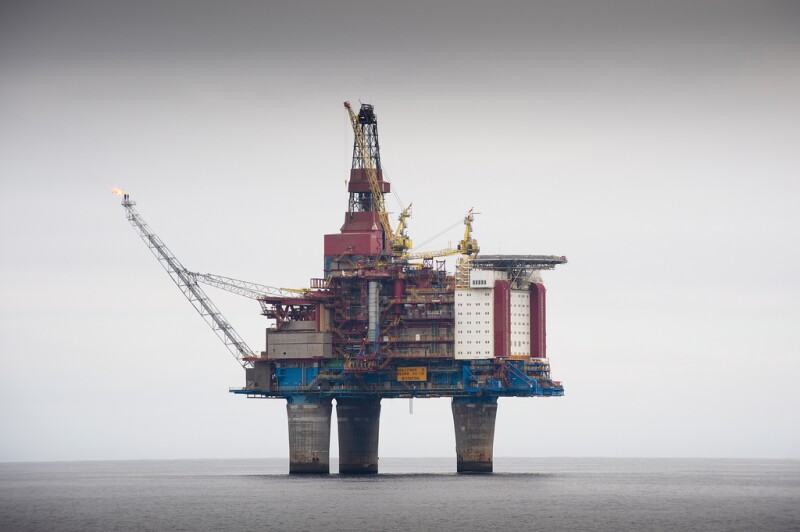The North Sea sits between Great Britain, Norway, Denmark, Germany, the Netherlands, Belgium, and France in the Atlantic Ocean (Fig. 1). It has long hosted key northern European shipping lanes, provides a major fishery, and more recently, serves as a growing source of renewable wind and wave power. It is a popular destination for recreation and tourism in bordering countries. It has also been one of Europe’s most important sources of oil and natural gas since the discovery of its offshore reservoirs in the late 1950s and early 1960s.
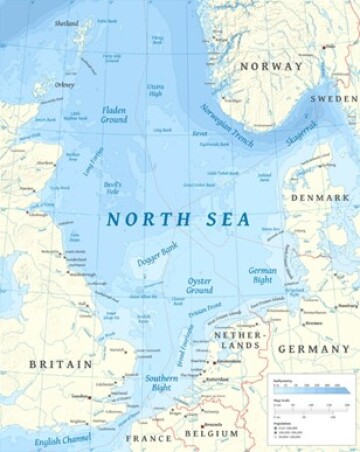
Discovery and Development
The first discoveries of oil and gas in the North Sea occurred on shore in the second half of the 1800s and the early 1900s. The first discovery of gas in quantity, also on shore, occurred in 1959 in what later became known as the Groningen gas field in the Netherlands. Deepwater exploration was only made possible in 1964 by the Convention on the Continental Shelf. This UN measure gave countries with coastlines sovereignty over the continental shelves and their associated natural resources off their shores, something that had been previously limited by international law. The countries with coasts on the North Sea received an exclusive economic zone in which they could license development of any natural resources found. The first offshore discovery of gas in the North Sea was made by BP’s Sea Gem in the West Sole field in September 1965 with subsequent gas discoveries coming thick and fast. The Sea Gem capsized only a few months after this initial discovery, a harbinger of the challenging conditions operations in the North Sea would face. Oil was not discovered offshore until 1969 when Phillips Petroleum drilled a successful well in what later became known as the Ekofisk field in the Norwegian sector. Subsequent development in the North Sea was galvanized by oil crises in 1973 and 1979, both of which drove up oil prices and improved the economics of the North Sea. Today, there are hundreds of known oil and gas fields in the North Sea (Fig. 2), including the eponymous Brent field, discovered in 1971, which lent its name to the benchmark Brent crude (although today the benchmark is a blend of crudes from the North Sea).
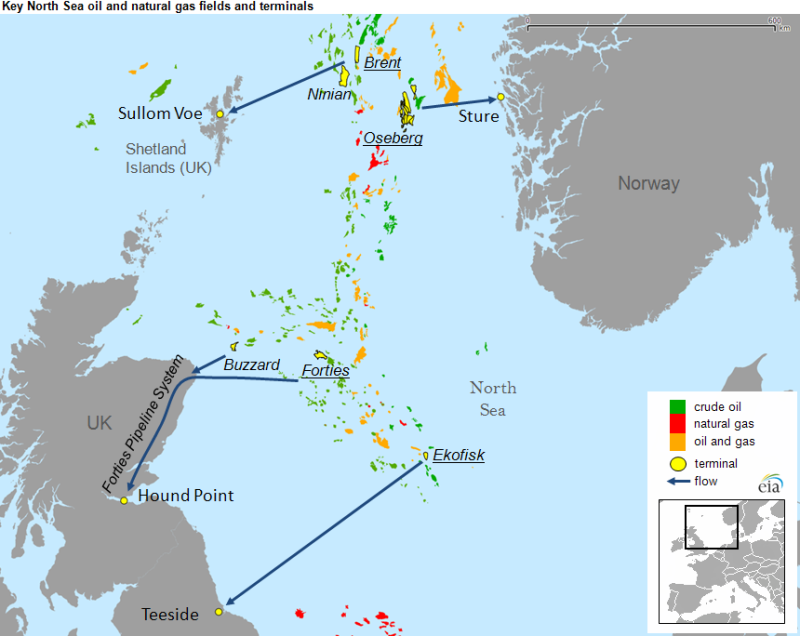
The Producing Years
The vast majority of North Sea reserves fell under the jurisdictions of the UK and Norway. Consequently, these two countries also account for the majority of production in the North Sea. Oil production peaked in the late 90s at just over 6 million B/D (Fig. 3). Production has been falling relatively steadily since, and, after oil and gas demand was battered by the COVID-19 pandemic, reached lows not seen since its inception. However, despite being in what might be a terminal decline, the North Sea has had a significant impact over the past 50+ years.
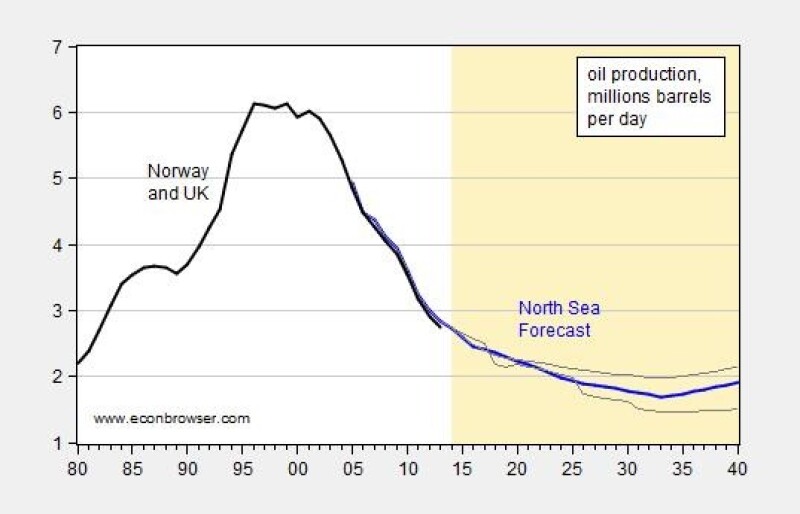
Most readily apparent is its direct economic contributions: in 2018, North Sea production contributed £24 billion ($31.2 billion at the time this article was written) to UK GDP (1.2% of the UK total) and was estimated to support around 270,000 jobs across the UK in 2019.

In Norway, which exports roughly 90% of its production, the impact has been even larger. Over its lifetime, the North Sea has contributed approximately NOK 16.5 trillion ($1.82 trillion at the time of writing) in today’s NOK to the economy. In 2021 alone, it made up 20% of GDP, 20% of government revenues, 20% of investments, and 50% of total exports (Fig. 4). Over the lifetime of the North Sea, its production has consistently accounted for 10–30% of each of these figures (Fig. 5). This revenue allowed Norway to create the Government Pension Fund of Norway, or, simply, “the Fund,” which it has been able to use to smooth government income and provide generous social services despite the fluctuation in oil prices. The Fund is worth around NOK 11.5 trillion and is one of the world’s largest sovereign wealth funds.
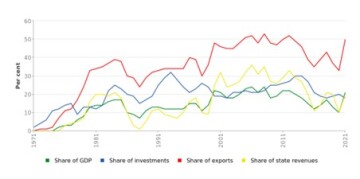
In addition to its raw economic heft, the North Sea, by virtue of being renowned as one of the most inhospitable locations for oil and gas operations, demanded innovation in offshore operations. Design solutions like steel jackets, concrete gravity platforms, tethered semisubmersibles, tension-leg platforms, and underwater manifold systems are all products of North Sea innovation. The chop in the surrounding seas made tanker loading difficult and necessitated a way to temporarily store significant amounts of oil at sea. This in turn gave birth to the Condeep—a giant concrete-reinforced production platform with huge storage tanks—patented and developed in Norway in 1972. In a somewhat ironic twist, some of these innovations are now used to form the base for offshore wind facilities destined for the North Sea.
While spurring technical innovations, these conditions have also been party to a number of tragedies, beginning with the capsizing of the Sea Gem and including one of the worst oilfield disasters in history—the Piper Alpha. These tragedies resulted in step changes in safety and spurred developments in offshore safety that are still in force today.
The Twilight Years
Consistent production declines have been matched by a drop in exploration activities. In the mid-2010s, plug and abandonment (P&A) activity began to exceed exploration and production (E&P) activity (Fig. 6). Decommissioning will involve hundreds of wells and billions of dollars over many years. A combination of dwindling discoveries, increasing costs, the price crash of 2014–2016, and a strong European push to phase out petroleum-based energy sources has created a business climate as inhospitable as the North Sea itself. Although recent underinvestment in the E&P sector and concerns about supply stability due to geopolitical turmoil have driven oil and gas prices near 10-year highs, the most this is likely to offer by way of respite is a delay in the decommissioning timelines: North Sea conventional wells costs are high, and technically complex offshore projects are often developed on timelines that are measured in decades. Even if current elevated prices were to last for years, the combination of extended time horizons, costly projects, and an unfavorable regulatory environment mean the North Sea is not situated to act as a swing producer—OPEC and America’s frackers now compete for that crown.
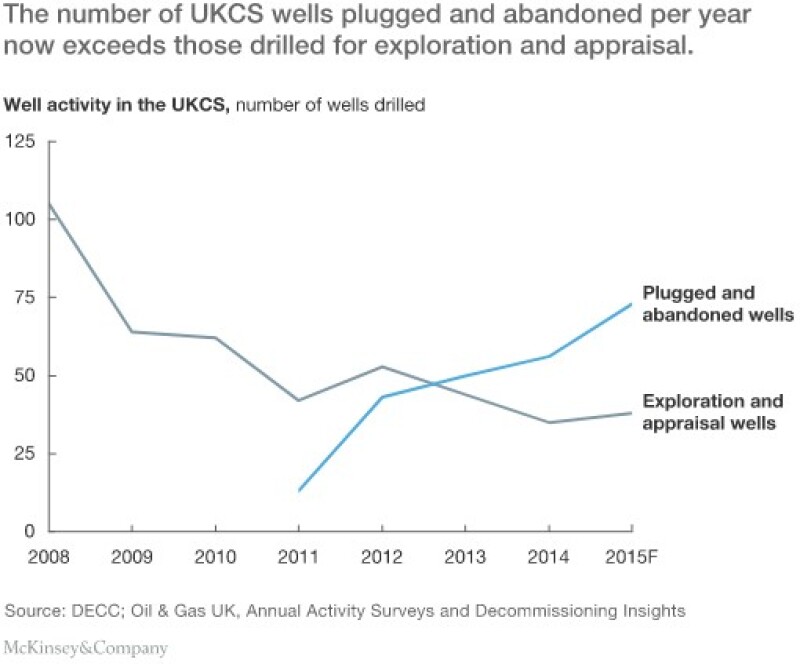
The Legacy
While engineers who thrive on the complexities of deepwater development may bemoan the decrease in such opportunities, it is also a testament to the prowess of the industry. Technical progression has made previously uneconomic onshore shale reserves more accessible, driving down prices and turning expensive offshore developments into a luxury, not a necessity. The engineering wheel never stops turning, however, and it may one day come to pass that, even with a heavy regulatory burden, new technology makes even the most daunting of offshore operations look economically feasible again. Even if such a development does not come to pass, the North Sea should still be remembered for its role as a critical resource during the oil crises of the 1970s, an economic boon for the UK and Norway, and an inspiration for technical developments that are still in use around the world today, both within and outside of the industry.

